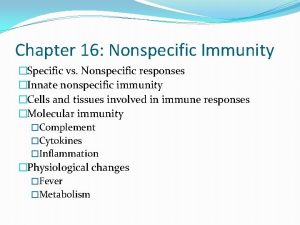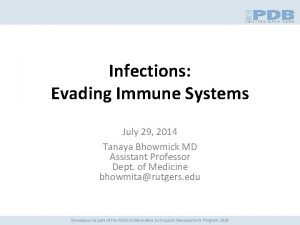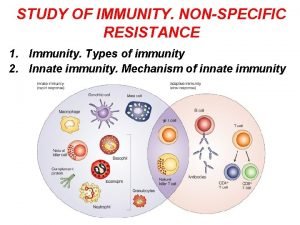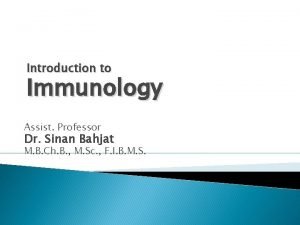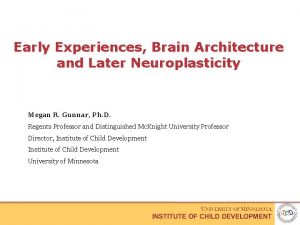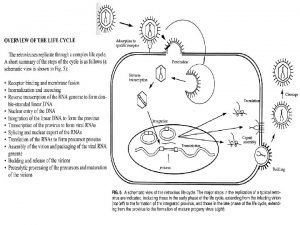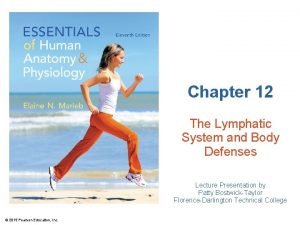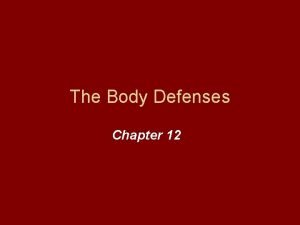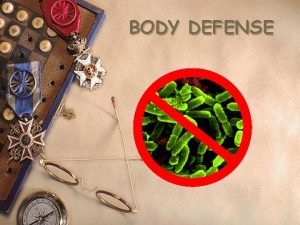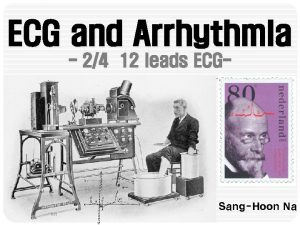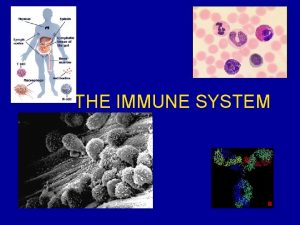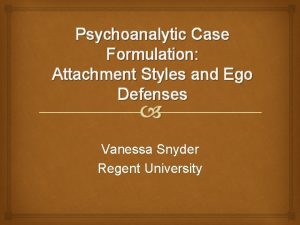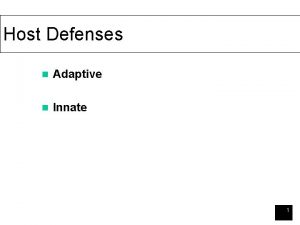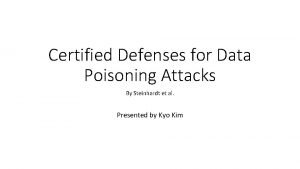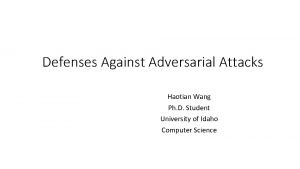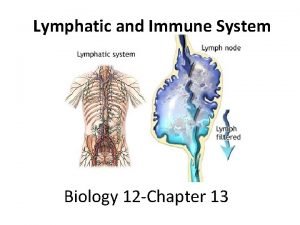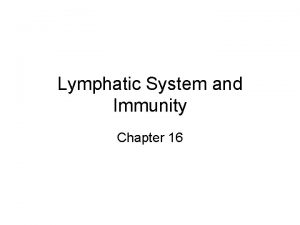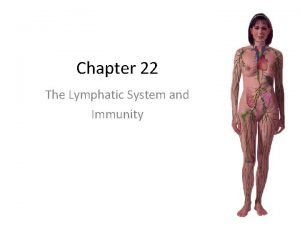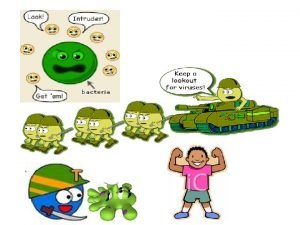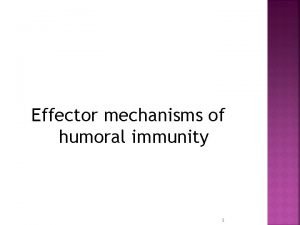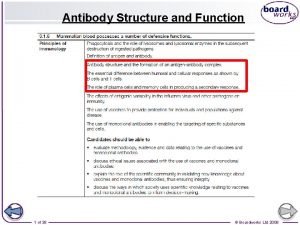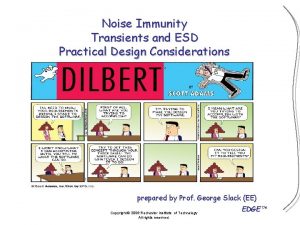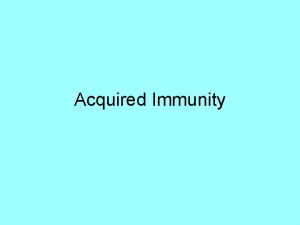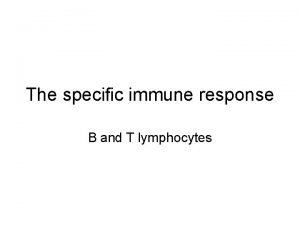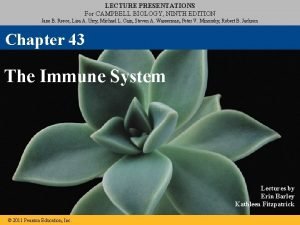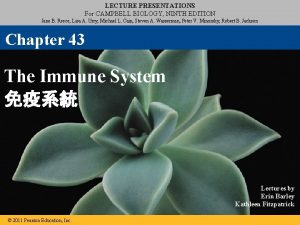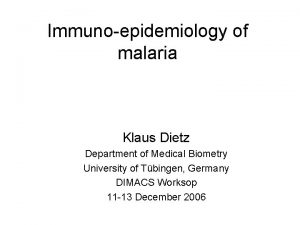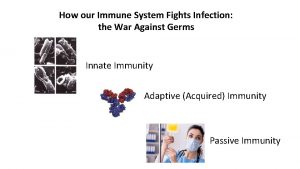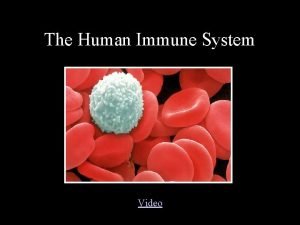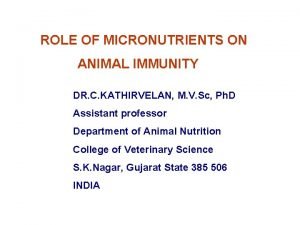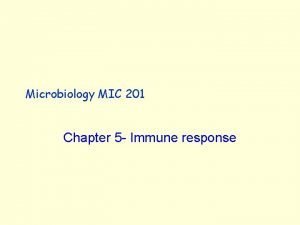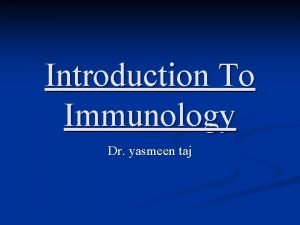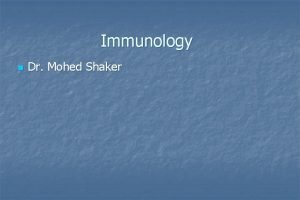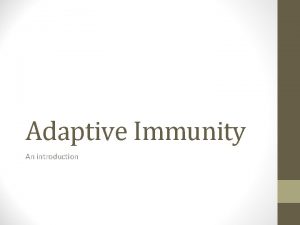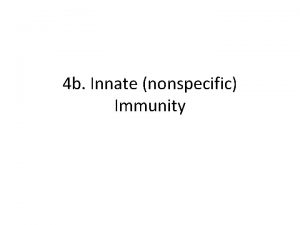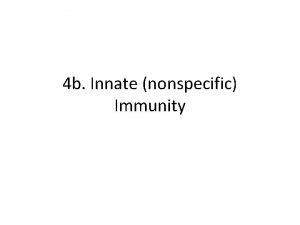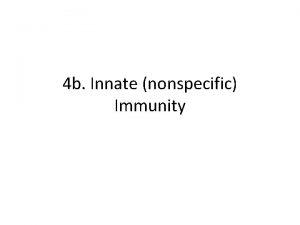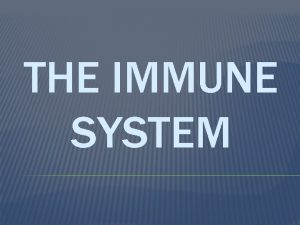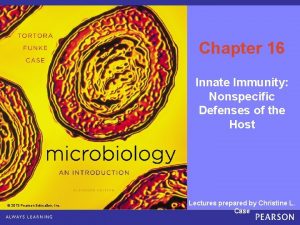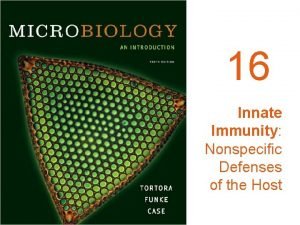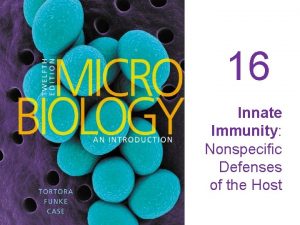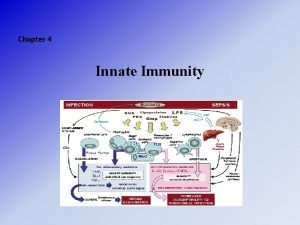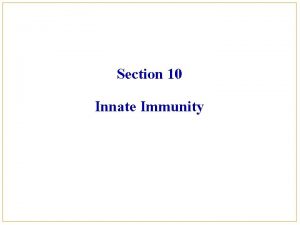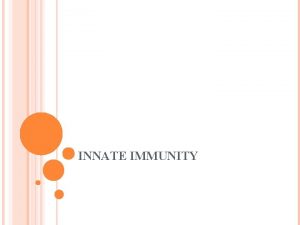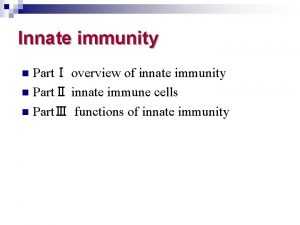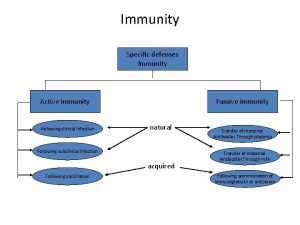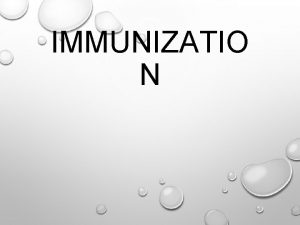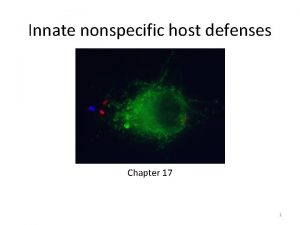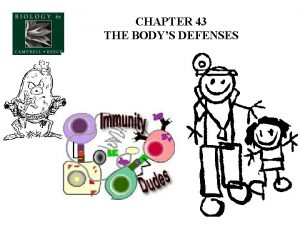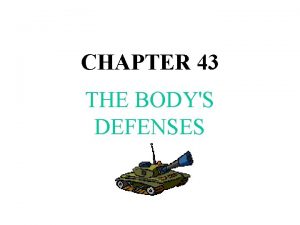Chapter 16 Innate Immunity Nonspecific Defenses of the





















































- Slides: 53

Chapter 16: Innate Immunity: Nonspecific Defenses of the Host First Line of Defense Second Line of Defense Phagocytosis Antimicrobial Substances $100 $100 $200 $200 $300 $300 $400 $400 $500 $500 © 2013 Pearson Education, Inc. Innate Immunity FINAL ROUND

Topic 1: First Line of Defense $100 Question Which of the following prevents microorganisms from entering the lower respiratory tract? a. lysozyme b. epiglottis c. ciliary escalator d. mucus ANSWER © 2013 Pearson Education, Inc. BACK TO GAME

Topic 1: First Line of Defense $100 Answer Which of the following prevents microorganisms from entering the lower respiratory tract? a. lysozyme b. epiglottis c. ciliary escalator d. mucus © 2013 Pearson Education, Inc. BACK TO GAME

Topic 1: First Line of Defense $200 Question Which of the following is NOT part of the body’s first line of defense? a. b. c. d. skin mucous membranes saliva fever ANSWER © 2013 Pearson Education, Inc. BACK TO GAME

Topic 1: First Line of Defense $200 Answer Which of the following is NOT part of the body’s first line of defense? a. skin b. mucous membranes c. saliva d. fever © 2013 Pearson Education, Inc. BACK TO GAME

Topic 1: First Line of Defense $300 Question The so-called ciliary escalator functions by a. moving microbes towards the lower respiratory tract. b. killing microbes. c. moving microbes toward the throat. d. moving microbes from the nose. ANSWER © 2013 Pearson Education, Inc. BACK TO GAME

Topic 1: First Line of Defense $300 Answer The so-called ciliary escalator functions by a. moving microbes towards the lower respiratory tract. b. killing microbes. c. moving microbes toward the throat. d. moving microbes from the nose. © 2013 Pearson Education, Inc. BACK TO GAME

Topic 1: First Line of Defense $400 Question The p. H of skin that is believed to discourage the growth of many microorganisms is a. b. c. d. 6 to 7. 3 to 5. 1 to 3. 8 to 9. ANSWER © 2013 Pearson Education, Inc. BACK TO GAME

Topic 1: First Line of Defense $400 Answer The p. H of skin that is believed to discourage the growth of many microorganisms is a. 6 to 7. b. 3 to 5. c. 1 to 3. d. 8 to 9. © 2013 Pearson Education, Inc. BACK TO GAME

Topic 1: First Line of Defense $500 Question Which of the following bacteria neutralizes stomach acid, allowing the bacterium to grow in the stomach? a. b. c. d. Clostridium botulinum Streptococcus mutans Lactobacillus pyogenes Helicobacter pylori ANSWER © 2013 Pearson Education, Inc. BACK TO GAME

Topic 1: First Line of Defense $500 Answer Which of the following bacteria neutralizes stomach acid, allowing the bacterium to grow in the stomach? a. b. c. d. Clostridium botulinum Streptococcus mutans Lactobacillus pyogenes Helicobacter pylori © 2013 Pearson Education, Inc. BACK TO GAME

Topic 2: Second Line of Defense $100 Question What do the granules released by NK cells contain? a. b. c. d. histamine granzymes and perforin peroxide ions complement proteins ANSWER © 2013 Pearson Education, Inc. BACK TO GAME

Topic 2: Second Line of Defense $100 Answer What do the granules released by NK cells contain? a. histamine b. granzymes and perforin c. peroxide ions d. complement proteins © 2013 Pearson Education, Inc. BACK TO GAME

Topic 2: Second Line of Defense $200 Question Which leukocytes function to produce toxins against certain parasites? a. b. c. d. lymphocytes basophils eosinophils neutrophils ANSWER © 2013 Pearson Education, Inc. BACK TO GAME

Topic 2: Second Line of Defense $200 Answer Which leukocytes function to produce toxins against certain parasites? a. b. c. d. lymphocytes basophils eosinophils neutrophils © 2013 Pearson Education, Inc. BACK TO GAME

Topic 2: Second Line of Defense $300 Question Which of the following is classified as an agranulocyte? a. b. c. d. monocyte neutrophil eosinophil basophil ANSWER © 2013 Pearson Education, Inc. BACK TO GAME

Topic 2: Second Line of Defense $300 Answer Which of the following is classified as an agranulocyte? a. b. c. d. monocyte neutrophil eosinophil basophil © 2013 Pearson Education, Inc. BACK TO GAME

Topic 2: Second Line of Defense $400 Question What substances released by damaged cells intensify the effects of inflammation? a. b. c. d. prostaglandins leukotrienes kinins acute-phase proteins ANSWER © 2013 Pearson Education, Inc. BACK TO GAME

Topic 2: Second Line of Defense $400 Answer What substances released by damaged cells intensify the effects of inflammation? a. b. c. d. prostaglandins leukotrienes kinins acute-phase proteins © 2013 Pearson Education, Inc. BACK TO GAME

Topic 2: Second Line of Defense $500 Question During inflammation, there is activation and increased concentration of a group of proteins in the blood called a. b. c. d. kinins. leukotrienes. prostaglandins. acute-phase proteins. ANSWER © 2013 Pearson Education, Inc. BACK TO GAME

Topic 2: Second Line of Defense $500 Answer During inflammation, there is activation and increased concentration of a group of proteins in the blood called a. kinins. b. leukotrienes. c. prostaglandins. d. acute-phase proteins. © 2013 Pearson Education, Inc. BACK TO GAME

Topic 3: Phagocytosis $100 Question The attraction of phagocytes to microorganisms is called a. b. c. d. chemotaxis. adherence. opsonization. ingestion. ANSWER © 2013 Pearson Education, Inc. BACK TO GAME

Topic 3: Phagocytosis $100 Answer The attraction of phagocytes to microorganisms is called a. b. c. d. chemotaxis. adherence. opsonization. ingestion. © 2013 Pearson Education, Inc. BACK TO GAME

Topic 3: Phagocytosis $200 Question Which macrophages are located in certain tissues and organs of the body? a. b. c. d. fixed macrophages wandering macrophages reticuloendothelial system mononuclear phagocytic system ANSWER © 2013 Pearson Education, Inc. BACK TO GAME

Topic 3: Phagocytosis $200 Answer Which macrophages are located in certain tissues and organs of the body? a. b. c. d. fixed macrophages wandering macrophages reticuloendothelial system mononuclear phagocytic system © 2013 Pearson Education, Inc. BACK TO GAME

Topic 3: Phagocytosis $300 Question Fixed macrophages that are found in the liver are called a. b. c. d. alveolar macrophages. microglial cells. Kupffer’s cells. peritoneal macrophages. ANSWER © 2013 Pearson Education, Inc. BACK TO GAME

Topic 3: Phagocytosis $300 Answer Fixed macrophages that are found in the liver are called a. b. c. d. alveolar macrophages. microglial cells. Kupffer’s cells. peritoneal macrophages. © 2013 Pearson Education, Inc. BACK TO GAME

Topic 3: Phagocytosis $400 Question The indigestible material in the phagolysosome is called the a. b. c. d. Golgi body. residual body. phagosome. lysozyme. ANSWER © 2013 Pearson Education, Inc. BACK TO GAME

Topic 3: Phagocytosis $400 Answer The indigestible material in the phagolysosome is called the a. Golgi body. b. residual body. c. phagosome. d. lysozyme. © 2013 Pearson Education, Inc. BACK TO GAME

Topic 3: Phagocytosis $500 Question Which of the following organisms produces membrane attack complexes? a. Listeria monocytogenes b. Haemophilus influenzae c. Mycobacterium tuberculosis d. Pseudomonas aeruginosa ANSWER © 2013 Pearson Education, Inc. BACK TO GAME

Topic 3: Phagocytosis $500 Answer Which of the following organisms produces membrane attack complexes? a. Listeria monocytogenes b. Haemophilus influenzae c. Mycobacterium tuberculosis d. Pseudomonas aeruginosa © 2013 Pearson Education, Inc. BACK TO GAME

Topic 4: Antimicrobial Substances $100 Question Complement proteins are numbered a. b. c. d. C 1 to C 6. C 1 to C 7. C 1 to C 8. C 1 to C 9. ANSWER © 2013 Pearson Education, Inc. BACK TO GAME

Topic 4: Antimicrobial Substances $100 Answer Complement proteins are numbered a. C 1 to C 6. b. C 1 to C 7. c. C 1 to C 8. d. C 1 to C 9. © 2013 Pearson Education, Inc. BACK TO GAME

Topic 4: Antimicrobial Substances $200 Question Interferons are produced by certain animal cells after being stimulated by a. protozoa. b. bacteria. c. viruses. d. fungi. ANSWER © 2013 Pearson Education, Inc. BACK TO GAME

Topic 4: Antimicrobial Substances $200 Answer Interferons are produced by certain animal cells after being stimulated by a. protozoa. b. bacteria. c. viruses. d. fungi. © 2013 Pearson Education, Inc. BACK TO GAME

Topic 4: Antimicrobial Substances $300 Question How many principal types of interferons do humans have? a. 2 b. 3 c. 4 d. 5 ANSWER © 2013 Pearson Education, Inc. BACK TO GAME

Topic 4: Antimicrobial Substances $300 Answer How many principal types of interferons do humans have? a. 2 b. 3 c. 4 d. 5 © 2013 Pearson Education, Inc. BACK TO GAME

Topic 4: Antimicrobial Substances $400 Question Which antimicrobial peptide do sweat glands produce? a. defensin b. dermicidin c. cathelicidin d. thrombocidin ANSWER © 2013 Pearson Education, Inc. BACK TO GAME

Topic 4: Antimicrobial Substances $400 Answer Which antimicrobial peptide do sweat glands produce? a. defensin b. dermicidin c. cathelicidin d. thrombocidin © 2013 Pearson Education, Inc. BACK TO GAME

Topic 4: Antimicrobial Substances $500 Question Some bacteria evade the complement system by means of their a. endospores. b. flagella. c. cilia. d. capsules. ANSWER © 2013 Pearson Education, Inc. BACK TO GAME

Topic 4: Antimicrobial Substances $500 Answer Some bacteria evade the complement system by means of their a. endospores. b. flagella. c. cilia. d. capsules. © 2013 Pearson Education, Inc. BACK TO GAME

Topic 5: Innate Immunity $100 Question Which host defense is more effective against gram-positive bacteria than gram-negative bacteria? a. b. c. d. mucus sebum gastric juice lysozyme ANSWER © 2013 Pearson Education, Inc. BACK TO GAME

Topic 5: Innate Immunity $100 Answer Which host defense is more effective against gram-positive bacteria than gram-negative bacteria? a. mucus b. sebum c. gastric juice d. lysozyme © 2013 Pearson Education, Inc. BACK TO GAME

Topic 5: Innate Immunity $200 Question Which chemical factor digests peptidoglycan in perspiration, tears, and saliva? a. b. c. d. sebum lysozyme antimicrobial peptides lactoferrin ANSWER © 2013 Pearson Education, Inc. BACK TO GAME

Topic 5: Innate Immunity $200 Answer Which chemical factor digests peptidoglycan in perspiration, tears, and saliva? a. sebum b. lysozyme c. antimicrobial peptides d. lactoferrin © 2013 Pearson Education, Inc. BACK TO GAME

Topic 5: Innate Immunity $300 Question What inhibits cell wall synthesis, forms pores in the plasma membrane, and destroys DNA and RNA in microbes? a. b. c. d. the complement system antimicrobial peptides iron-binding proteins interferons ANSWER © 2013 Pearson Education, Inc. BACK TO GAME

Topic 5: Innate Immunity $300 Answer What inhibits cell wall synthesis, forms pores in the plasma membrane, and destroys DNA and RNA in microbes? a. the complement system b. antimicrobial peptides c. iron-binding proteins d. interferons © 2013 Pearson Education, Inc. BACK TO GAME

Topic 5: Innate Immunity $400 Question What process intensifies the effects of interferons? a. b. c. d. phagocytosis inflammation fever release of natural killer cells ANSWER © 2013 Pearson Education, Inc. BACK TO GAME

Topic 5: Innate Immunity $400 Answer What process intensifies the effects of interferons? a. b. c. d. phagocytosis inflammation fever release of natural killer cells © 2013 Pearson Education, Inc. BACK TO GAME

Topic 5: Innate Immunity $500 Question What do the activated fixed macrophages secrete to bring about vasodilation, increased permeability, and clot formation? a. b. c. d. prostaglandins leukotrienes cytokines histamine ANSWER © 2013 Pearson Education, Inc. BACK TO GAME

Topic 5: Innate Immunity $500 Answer What do the activated fixed macrophages secrete to bring about vasodilation, increased permeability, and clot formation? a. b. c. d. prostaglandins leukotrienes cytokines histamine © 2013 Pearson Education, Inc. BACK TO GAME

FINAL ROUND Question The high temperature in a fever increases the production of a. transferrins. b. leukotrienes. c. lectins. d. siderophores. ANSWER © 2013 Pearson Education, Inc. BACK TO GAME

FINAL ROUND Answer The high temperature in a fever increases the production of a. transferrins. b. leukotrienes. c. lectins. d. siderophores. © 2013 Pearson Education, Inc. BACK TO GAME
 Difference between acquired immunity and innate immunity
Difference between acquired immunity and innate immunity Nonspecific vs specific immunity
Nonspecific vs specific immunity Assis prof
Assis prof Innate immunity examples
Innate immunity examples Non specific innate immunity
Non specific innate immunity Innate immunity first line of defense
Innate immunity first line of defense Innate immunity
Innate immunity Second line of defense immune system
Second line of defense immune system Innate immunity first line of defense
Innate immunity first line of defense Innate immunity first line of defense
Innate immunity first line of defense Phagocytr
Phagocytr Innate immunity
Innate immunity Chapter 12 the lymphatic system and body defenses
Chapter 12 the lymphatic system and body defenses Chapter 12 the lymphatic system and body defenses
Chapter 12 the lymphatic system and body defenses Chapter 12 the lymphatic system and body defenses
Chapter 12 the lymphatic system and body defenses Nonspecific defense mechanisms
Nonspecific defense mechanisms Specific vs nonspecific defense
Specific vs nonspecific defense Abnormal vq scan images
Abnormal vq scan images Short pr interval
Short pr interval Nonspecific host defense mechanism
Nonspecific host defense mechanism Nonspecific vs specific defense
Nonspecific vs specific defense Splitting defense mechanism example
Splitting defense mechanism example Host defenses
Host defenses Neur ips
Neur ips Certified defenses for data poisoning attacks
Certified defenses for data poisoning attacks Nicolas papernot
Nicolas papernot Chapter 13 lymphatic system and immunity
Chapter 13 lymphatic system and immunity Chapter 16 lymphatic system and immunity
Chapter 16 lymphatic system and immunity Chapter 22 lymphatic system and immunity
Chapter 22 lymphatic system and immunity Primary vs secondary immune response
Primary vs secondary immune response Define immunity
Define immunity Effector mechanism of humoral immunity
Effector mechanism of humoral immunity Canra passed
Canra passed Humoral and cell mediated immunity difference
Humoral and cell mediated immunity difference Adaptive noise immunity
Adaptive noise immunity Keva immunity booster
Keva immunity booster Conducted immunity test
Conducted immunity test Wepapers
Wepapers Acquired immunity definition
Acquired immunity definition Immunity
Immunity Active vs passive immunity
Active vs passive immunity Non specific immunity
Non specific immunity Opsonization
Opsonization Cell mediated immunity
Cell mediated immunity Adaptative immunity
Adaptative immunity Immune system def
Immune system def Passive immunity
Passive immunity What is immunity
What is immunity Lupus
Lupus Conclusion of immunity
Conclusion of immunity What is isoprinosine used for
What is isoprinosine used for Passive vs active immunity
Passive vs active immunity What is immunity
What is immunity What is immunity
What is immunity

